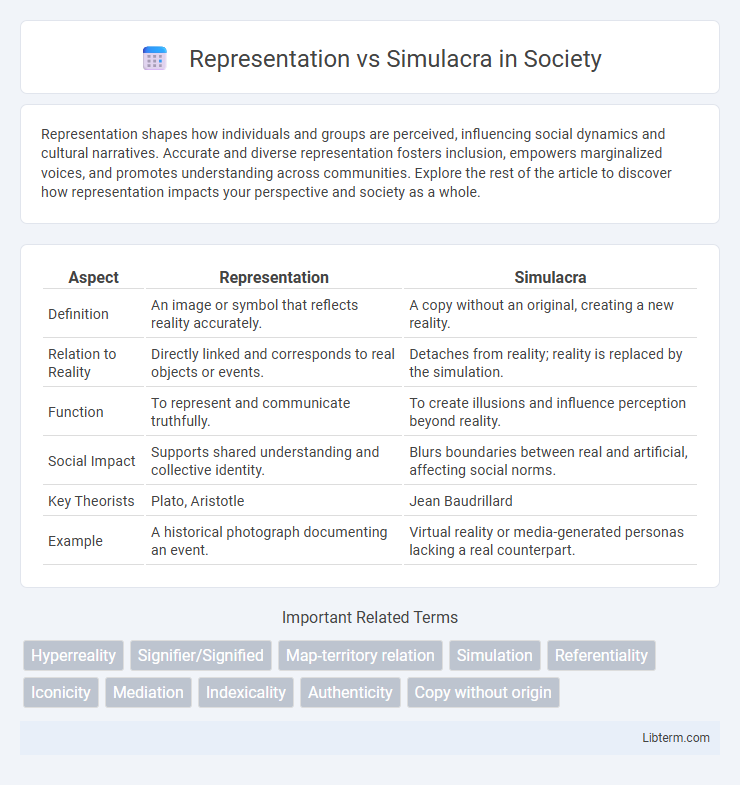Representation shapes how individuals and groups are perceived, influencing social dynamics and cultural narratives. Accurate and diverse representation fosters inclusion, empowers marginalized voices, and promotes understanding across communities. Explore the rest of the article to discover how representation impacts your perspective and society as a whole.
Table of Comparison
| Aspect | Representation | Simulacra |
|---|---|---|
| Definition | An image or symbol that reflects reality accurately. | A copy without an original, creating a new reality. |
| Relation to Reality | Directly linked and corresponds to real objects or events. | Detaches from reality; reality is replaced by the simulation. |
| Function | To represent and communicate truthfully. | To create illusions and influence perception beyond reality. |
| Social Impact | Supports shared understanding and collective identity. | Blurs boundaries between real and artificial, affecting social norms. |
| Key Theorists | Plato, Aristotle | Jean Baudrillard |
| Example | A historical photograph documenting an event. | Virtual reality or media-generated personas lacking a real counterpart. |
Understanding Representation: Concepts and Origins
Representation involves the use of signs, symbols, or images to depict reality, aiming to convey meaning and communicate truth. Originating from linguistic and philosophical theories, its concept traces back to Plato's notion of mimesis and Aristotle's ideas of imitation, emphasizing the relationship between the signifier and the signified. This foundational understanding contrasts sharply with simulacra, which refer to copies without originals, highlighting the shift from representation to hyperreality in contemporary cultural theory.
Defining Simulacra: Beyond Mere Imitation
Simulacra refer to copies or representations that no longer have an original referent, existing as independent realities rather than mere imitations of something real. Unlike traditional representation, which is a faithful depiction of an original object or concept, simulacra blur the boundaries between reality and imitation, creating a hyperreal dimension where distinctions between the authentic and the reproduced collapse. This concept is central to postmodern theory, illustrating how media, culture, and technology generate realities that are self-referential and detached from any authentic source.
Historical Context: Representation in Art and Culture
Representation in art emerged as a pivotal concept during the Renaissance, emphasizing accurate depiction of reality to convey social, religious, and political meanings. The Enlightenment further shifted focus toward rationality and individual perception, embedding representation with cultural significance reflecting evolving ideologies. By contrast, postmodern critiques, influenced by theorists like Baudrillard, challenged the authenticity of representation, arguing that simulacra--copies without originals--permeate contemporary culture, distorting historical and cultural narratives.
The Rise of Simulacra in Postmodern Thought
The rise of simulacra in postmodern thought challenges traditional representation by suggesting that images and signs no longer refer to any underlying reality, but instead create their own autonomous worlds. Jean Baudrillard's theory highlights how contemporary society is dominated by hyperreality, where simulations replace genuine experience, dissolving the boundary between the real and the copy. This shift undermines the notion of objective truth and reshapes cultural, social, and media landscapes through pervasive replication and simulation.
Representation vs. Simulacra: Key Differences
Representation involves depicting reality through symbols or images that correspond to original objects, maintaining a clear link to truth and authenticity. Simulacra replace the original reference by generating copies without an authentic source, leading to a hyperreal environment where distinctions between reality and imitation blur. Key differences lie in representation's grounding in reality versus simulacra's creation of self-referential signs that simulate reality without direct connection.
The Influence of Media: Reality or Simulation?
Media shapes perceptions by blurring boundaries between representation and simulacra, often replacing reality with hyperreal simulations that audiences accept as authentic. This phenomenon, rooted in Baudrillard's theory, asserts that media-generated images no longer reflect an original reality but instead create a self-referential cycle of signs detached from truth. The influence of media thus challenges traditional notions of authenticity, making simulations a dominant mode through which individuals experience culture and social reality.
Jean Baudrillard and the Theory of Simulacra
Jean Baudrillard's Theory of Simulacra challenges traditional notions of representation by arguing that in contemporary society, simulations have replaced reality, creating hyperreal copies with no original referent. Baudrillard identifies four stages of simulacra: the faithful copy, perversion of reality, pretence of reality, and pure simulacrum where distinctions between reality and representation dissolve. This theory underscores how media, advertising, and digital culture perpetuate simulated realities, impacting perception and social experience profoundly.
Case Studies: Simulacra in Popular Culture
Simulacra in popular culture manifest through iconic examples like Disney's theme parks, which create hyperreal environments where the distinction between reality and fiction blurs, exemplifying Baudrillard's theory of simulation. Films such as The Matrix portray layered simulations that challenge perceptions of authenticity and highlight the dominance of constructed realities over genuine experience. These case studies illustrate how simulacra shape societal understanding by replacing authentic representation with manufactured experiences that gain independent meaning.
The Impact of Simulacra on Perception and Meaning
Simulacra distort perception by replacing reality with copies that lack original reference, leading to a hyperreal experience where distinctions between truth and imitation blur. This shift challenges traditional notions of meaning, as representations no longer reflect genuine objects but recreate fabricated realities shaped by media and consumer culture. Consequently, the impact of simulacra transforms society's understanding and interaction with truth, creating a landscape where simulated images and narratives dictate perception and value.
Future Implications: Navigating Representation in the Digital Age
Representation in the digital age increasingly blurs the line between reality and simulacra, where hyperreal images and data constructs shape perceptions more than authentic experiences. Advanced technologies like AI-generated content and virtual realities challenge traditional notions of truth, demanding critical navigation skills to decipher simulations from genuine representation. Future implications include ethical considerations in digital identity, authenticity verification, and the potential reshaping of societal trust through pervasive simulated realities.
Representation Infographic

 libterm.com
libterm.com